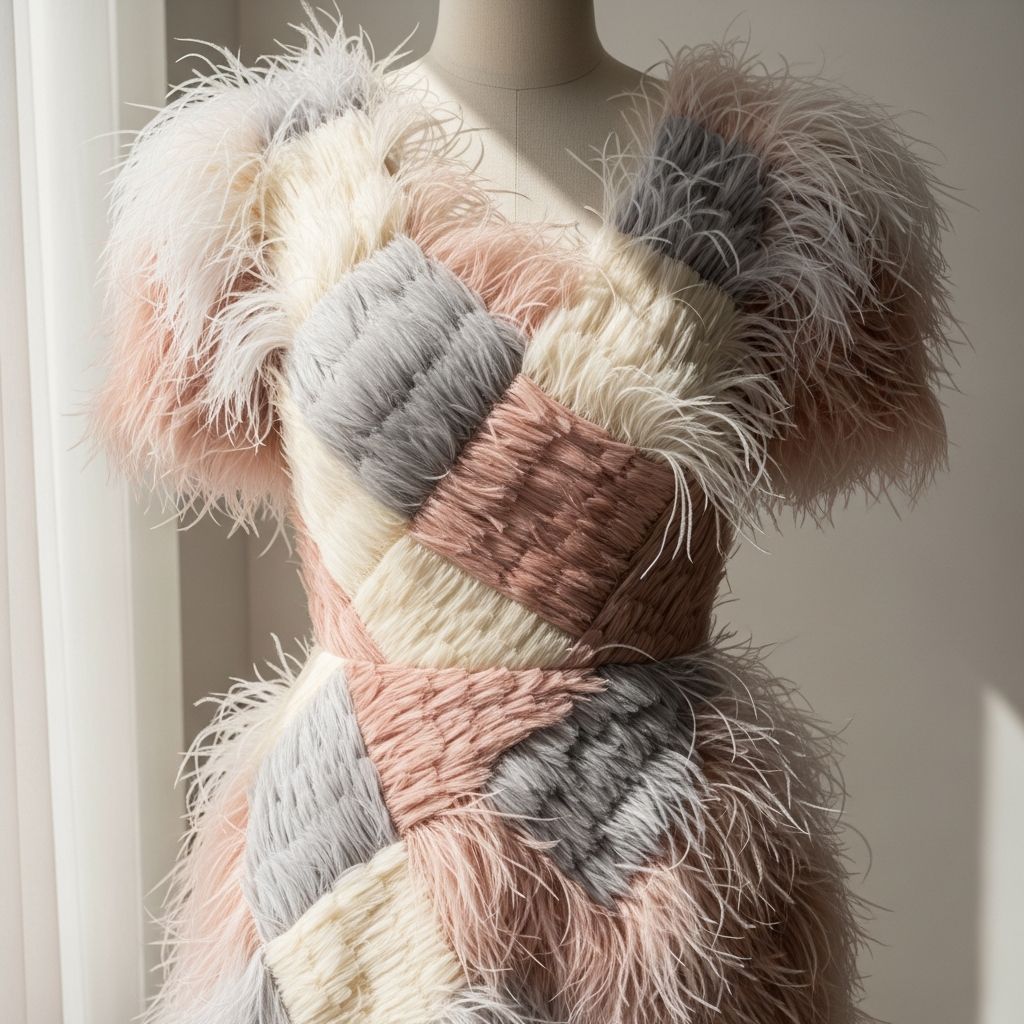Feather Blocked Dress DIY: Step-by-Step Guide to a Stylish Statement Piece
Elevate your wardrobe by transforming a simple dress with cascading feather trim for a chic, personalized look.

Feather Blocked Dress DIY
Adding feather trim to a simple dress is a bold way to elevate your wardrobe and turn heads at any event. Whether youre getting ready for a night out, a special party, or just want a unique day-to-night piece, this feather blocked dress DIY walks you through every step to create a professional and trendy look at home.
Why Choose Feather Trim?
Feather trim offers instant drama and movement, turning a basic garment into a statement. With endless options for colors and feather lengths, you can tailor your dress to fit both your personal style and the occasion.
- Instant glamour: Feathers instantly upgrade the look of any dress.
- Customization: Choose feather colors and densities to match your taste.
- Easy technique: No advanced sewing skills requiredjust patience and attention to detail.
Materials and Tools You Will Need
- A simple dress (straight or fitted styles work best)
- Feather trim (enough for several layers around the dressamount depends on your desired coverage and the dress width)
- Sewing machine with zigzag and straight stitch capacity
- Scissors
- Dressmakers pins
- Ruler or measuring tape
- Thread matching your dress or feather trim
- Fray check glue (to prevent feather ribbon unraveling)
- Hand sewing needle
Tip: Purchase a little extra feather trim to allow for overlap and to account for any mistakes.
Choosing Your Dress and Feather Trim
Dress Selection Tips
- Pick a dress with a simple silhouette for the best effectstright or A-line shapes are easiest.
- Solid color dresses let the texture and color of the feathers stand out.
- Avoid dresses with lots of embellishments or seams near the hemline, as these can interfere with feather placement.
Feather Trim Selection
- Plush, wide feather trims create a more dramatic, full effect.
- Narrower trims are subtle and good for a lighter, flirty look.
- Choose a color that contrasts with your dress for boldness, or a matching color for understated elegance.
- Look for feather trims on a sturdy ribbon backing for easier stitching.
Preparing and Planning the Design
Visualizing Feather Placement
Before attaching any feathers, decide where you want the lowest layer to sit relative to the dresss bottom edge. For best results, let the
feathers drape about 1 inch below the hem
. This creates a polished finish and lets the feathers move naturally as you walk.- Lay the dress flat on a work surface.
- Using a ruler, measure up from the hem and use straight pins to mark a line just above where your feather trim will attach.
- Start pinning from the back of the dress and work your way around so the overlap is hidden at the back seam.
Pro tip: Make sure your pins are evenly spaced and parallel to the hem for a professional finish. A ruler or measuring tape keeps everything level.
Attaching the First Feather Layer
- With the dress inside out or on the wrong side, line up your feather trim so it covers the area just beneath the pinned line.
- Carefully sew the top edge of the feather trims ribbon to the dress using a
zigzag stitch
. Start at one back seam and sew all the way around to meet back at the starting point. - When you reach the starting point, trim any excess and use a dab of fray check glue to seal the edge and prevent the ribbon from unravelling.
The zigzag stitch secures the trim while allowing the feathers to move. For non-top layers, the stitch will be completely covered by the layer above.
Adding Additional Feather Layers
Layering feathers creates fullness and dimension. To add the next row:
- Measure up from the dress hem for the next row, creating a new line of pins just above where the trim should be attached.
- Overlap the new trim so it covers the stitching on the row below. Adjust placement for best coveragethis depends on feather length and trim thickness.
- Repeat the process: attach the trim with a zigzag stitch, working around the dress and sealing the end with fray check glue.
- Number of layers depends on the length of your dress and size of the trim. Three to five layers is typical for a dramatic blocked look.
Tips for Consistent Layering
- Keep each layer evenly spaced for a neat, designer appearance.
- Use your ruler to mark consistent intervals.
- Adjust overlap so the feathers remain lush without gaps.
Finishing the Top Feather Layer
The final (top) feather layer is the most visible, so finesse is key:
- Attach the top trim using a straight stitch alongside the ribbon, instead of a zigzag, for a discrete finish.
- Check that the stitching is tight to prevent the top trim from shifting.
- If the feathers slip or create waves, hand sew the trim cord in place with a hidden stitch for extra security.
- Alternatively, if youre happy with the zigzag stitch on lower layers, you may do the same for the top trim to save time.
Neatness and Durability
- Always backstitch at the start and end of seams to avoid unraveling.
- Trim any loose threads and check all layers for secure attachment.
- Spot clean any glue spots or stray marks.
Optional Customizations
- Color Blocking: Use multiple feather colors for a fun, rainbow effect or a classic ombré fade.
- Variable Layer Widths: Experiment with combining wide and narrow trims for texture.
- Sleeve Embellishment: Apply feather trim to sleeve hems for added drama.
- Neckline Accents: Feather trim along the neckline offers high-fashion runway vibes.
Styling and Care Tips
- Pair the feather-blocked dress with simple heels and understated jewelry to let your creation shine.
- Store it flat or hang it with care—feathers can become bent if compressed.
- Spot clean only. Feathers do not tolerate machine washing. Use a gentle stain remover or a clean cloth to dab at any stains.
Pro tip: If feathers shed excessively, a quick spritz with hairspray can help them stay put for the night.
Troubleshooting Common Issues
- Uneven Layers: Carefully measure and pin each layer before sewing. Use tailors chalk to map placement.
- Trim Cord Frays: Always seal ends with fray check glue after cutting.
- Feathers Shift or Lift: Secure the ribbon with extra stitching or hand sewing where necessary.
- Visible Stitches: Hide zigzag stitches under overlapping layers, and use invisible thread for hand sewing on the top layer.
Table: Feather Layer Placement Guide
| Layer Number | Distance from Hem | Stitch Type | Tips |
|---|---|---|---|
| 1 (Bottom) | 1″ below hem | Zigzag | Covers hem, start at back seam |
| 2-4 (Middle) | 1.5″+ increments | Zigzag | Overlap each above layer to hide stitching |
| 5 (Top) | Near dress bodice | Straight (or zigzag) | Hand sew for invisible finish if desired |
Frequently Asked Questions (FAQs)
Q: Can I use glue instead of sewing for feather trim?
A: Sewing is recommended for durability, especially for larger dresses or gowns. Fabric glue can be used for lightweight pieces or temporary costumes, but may not hold up to movement or washing.
Q: What kind of needle should I use for sewing through feather trim?
A: Use a standard sewing needle for light to medium fabrics. For denser trims, a heavier universal or ballpoint needle may work best. Always test on scrap fabric first.
Q: How do I keep the feathers from shedding?
A: Purchase high-quality feather trim and handle gently during sewing. Light misting with hairspray can reduce shedding for a special event, but avoid over-handling.
Q: Can I machine wash a feather trim dress?
A: No. Feathers are delicate and should be spot cleaned only. Machine washing can damage both the feathers and the garment.
Q: Is this technique suitable for beginners?
A: Absolutely! Careful measuring and patient pinning are more important than advanced sewing skills. This DIY is accessible to anyone comfortable with basic sewing machine functions.
Final Thoughts
This feather blocked dress DIY delivers a striking garment tailored exactly to your style. The step-by-step layering ensures a full, editorial look, while measured stitching keeps everything neat. Stand out at your next gathering or create a one-of-a-kind piece for your wardrobe—either way, youll have a showstopper!












